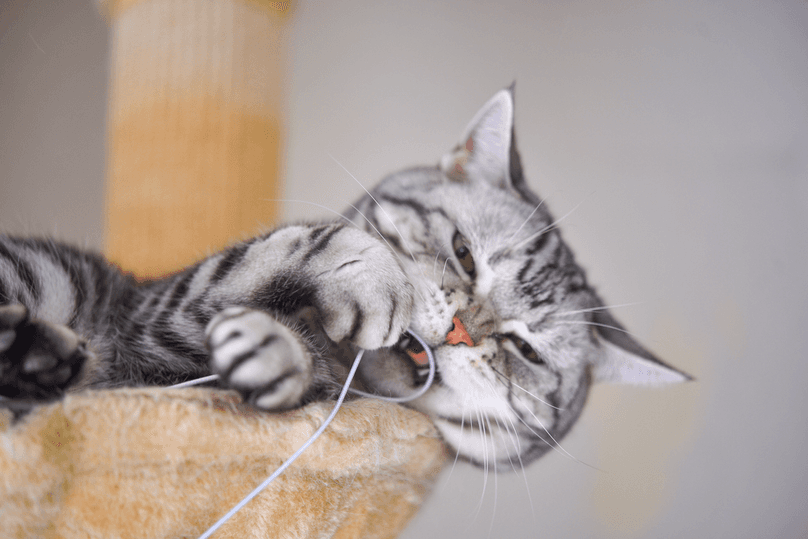
Q:My cat Frenchy loves to chase ribbons and string. She’d rather play with yarn for hours than play with her cat toys! Why do cats like string?
A:Cats can make a game of almost anything. So why do so many prefer string, yarn, or ribbon to the expensive cat toys we give them? To better understand the appeal of string, let’s talk a little about the way cats see.
Visual Perception in Cats
Feline eyes are structured differently than ours. Cat eyes have a structure called the “tapetum lucidum,” which acts like the reflectors behind your car’s headlights to gather and focus light. Thetapetum lucidumnot only lets cats see in low-light conditions, it allows them to hyper-focus on a specific prey item (or toy) before they pounce.
Cats also have the ability to rapidly change the size of their pupils, far more so than humans. Since cats hunt both by night and day, they need optimal vision in all lighting conditions. So, they can adjust their pupil size to provide effective vision in both bright sun and near darkness.
Also, feline eyes come with built-in motion sensors. Cat retinas have more of the rods that let them (as well as humans) see in low light. These rods are particularly sensitive to motion, allowing cats to pinpoint and hone in on even small movements.
Hunting Drive in Cats & Domestication
Before domestication, cats were more like today’s bobcats or lynxes living in the wild. As carnivores, they relied on their hunting instincts to catch and kill rodents, birds, and other small animals for food. As humans began to farm and harvest grain crops, rodents became a problem to which cats offered themselves as a ready solution. Cats controlled the vermin, both in the grain stores and in human homes, quickly making themselves indispensable mousers.
Cat eyes are built to spot movement. As rodent hunters, cats are hard-wired to notice even the twitch of a rat’s whisker or a mouse’s tail. To the feline brain, a wiggled string is the tail of a fleeing mouse—and in an instant your cat’s senses go on high alert, its vision goes into hyper-focus, and it’s game on!
String Play Stimulates the Cat Brain
Ever wonder how your cat relieves stress? String play is one of the best. It not only refocuses your cat’s attention, it releases endorphins that help keep your pet happy. As in humans, play is more than fun. It stimulates the brain, sharpens coordination, and exercises the muscles. For cats, they don’t just see string—they see an object that mimics the tail movements of small prey. It also heightens their brains’ problem-solving abilities, and fuels their desire to hunt (even when it’s not for survival).
If you have more than one cat, you’ve probably noticed their antics when they play together. Chasing a string or twine can promote group play as well as bonding among cats that aren’t from the same litter.
Texture Matters to Cats
In addition to being keen hunters, cats also enjoy getting their claws into things. Coarse string and twine offer your cat a pleasing texture that’s fun to hook a claw into. String or ribbon can be tied to other toys to make them more appealing to your cat. Even a string tied to a doorknob can provide your cat with hours of entertainment.
String Safety For Cats
As with even the simplest toys, there are safety concerns with string or twine. Here are a few tips.
- No loops or slipknots —For your cat’s safety, you can reduce strangulation risk by not looping the string or twine.
- Don’t use sewing thread —Thread designed for sewing is too thin and can catch on the roughness of your cat’s tongue, forcing your pet to swallow it. If ingested, thread greatly increases the risk for a bowel obstruction.
- Supervise your pet —Cats can get dangerously tangled in twine during play. Check on your pets regularly to be sure they’re not in distress.
- Things are not string —Don’t let your cat play with wires, electrical cords, fishing line, or rubber bands. These represent significant risks to the life and health of your pet.
Conclusion
String play can be a fun healthy way for your cat to hone its hunting instincts, sharpen its coordination, and release stress.When your cat chases string, it’s tapping into its most instincts, allowing that inner bobcat to have some fun.However, if you feel your cat has ingested something that it shouldn’t, or is displaying symptoms of digestive distress, contact your veterinarian immediately.